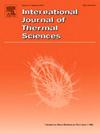Oxide nanoadditives as an effective route to thermal refinement of deep eutectic solvents
IF 4.9
2区 工程技术
Q1 ENGINEERING, MECHANICAL
International Journal of Thermal Sciences
Pub Date : 2025-05-08
DOI:10.1016/j.ijthermalsci.2025.109980
引用次数: 0
Abstract
This study explores thermophysical properties of highly concentrated (1–15 wt%) low-cost, easy-to-synthesize, and scalable nanofluids (NFs) based on deep eutectic solvent (low-viscosity choline chloride/ethylene glycol with molar ratio of 1:5) and metal/metalloid oxide nanoparticles (NPs) of different morphology (SiO2, Al2O3, TiO2, CuO), across various working temperatures, a topic not previously addressed in the literature. The NFs are characterized in terms of stability, nanoscale morphology, thermal properties, and rheological behavior. Applying oxide NPs reduces the costs of the dispersed phase by 50–99.8 % compared to other commercially available nanomaterials. The NPs in NFs form large agglomerates with Z-average hydrodynamic diameter of 112.4–535.7 nm and a polydispersity index of 0.232–0.406. It was found that nanosilica forms the most stable and fully transparent NFs. Thermal conductivity exhibits a linear increase from 1 % to 15 % (up to 0.255 W m−1 K−1 at 25 °C), regardless of NP type and temperature. Specific heat capacity remains high despite the presence of 15 wt% solids (1.979–2.292 kJ kg–1 K−1 at 23.5 °C). The viscosity augmentation of NFs occurs in the following order of NPs: CuO < TiO2 < Al2O3 < SiO2. Neat base liquid and 1–10 wt% NFs exhibit Newtonian behavior, while 15 wt% NFs are more complex shear-thinning media.

氧化物纳米添加剂是热细化深共晶溶剂的有效途径
本研究探索了基于深度共晶溶剂(低粘度氯化胆碱/乙二醇,摩尔比为1:5)和不同形态的金属/类金属氧化物纳米颗粒(SiO2, Al2O3, TiO2, CuO)的高浓度(1 - 15wt %)、低成本、易于合成和可扩展的纳米流体(NFs)在不同工作温度下的热物理性质,这是以前文献中未涉及的主题。NFs在稳定性,纳米级形貌,热性能和流变行为方面具有特征。与其他商用纳米材料相比,应用氧化物NPs可将分散相的成本降低50 - 99.8%。NFs中的NPs形成大团聚体,z -平均水动力直径为112.4 ~ 535.7 nm,多分散性指数为0.232 ~ 0.406。研究发现,纳米二氧化硅形成了最稳定、最透明的纳米颗粒。无论NP类型和温度如何,导热系数呈1%至15%的线性增长(在25°C时高达0.255 W m−1 K−1)。尽管存在15%的固体,比热容仍然很高(在23.5°C时,1.979-2.292 kJ kg-1 K−1)。NFs的粘度增加顺序如下:CuO <;二氧化钛& lt;氧化铝& lt;二氧化矽。纯基液和1-10 wt%的NFs表现出牛顿行为,而15 wt%的NFs是更复杂的剪切减薄介质。
本文章由计算机程序翻译,如有差异,请以英文原文为准。
求助全文
约1分钟内获得全文
求助全文
来源期刊

International Journal of Thermal Sciences
工程技术-工程:机械
CiteScore
8.10
自引率
11.10%
发文量
531
审稿时长
55 days
期刊介绍:
The International Journal of Thermal Sciences is a journal devoted to the publication of fundamental studies on the physics of transfer processes in general, with an emphasis on thermal aspects and also applied research on various processes, energy systems and the environment. Articles are published in English and French, and are subject to peer review.
The fundamental subjects considered within the scope of the journal are:
* Heat and relevant mass transfer at all scales (nano, micro and macro) and in all types of material (heterogeneous, composites, biological,...) and fluid flow
* Forced, natural or mixed convection in reactive or non-reactive media
* Single or multi–phase fluid flow with or without phase change
* Near–and far–field radiative heat transfer
* Combined modes of heat transfer in complex systems (for example, plasmas, biological, geological,...)
* Multiscale modelling
The applied research topics include:
* Heat exchangers, heat pipes, cooling processes
* Transport phenomena taking place in industrial processes (chemical, food and agricultural, metallurgical, space and aeronautical, automobile industries)
* Nano–and micro–technology for energy, space, biosystems and devices
* Heat transport analysis in advanced systems
* Impact of energy–related processes on environment, and emerging energy systems
The study of thermophysical properties of materials and fluids, thermal measurement techniques, inverse methods, and the developments of experimental methods are within the scope of the International Journal of Thermal Sciences which also covers the modelling, and numerical methods applied to thermal transfer.
 求助内容:
求助内容: 应助结果提醒方式:
应助结果提醒方式:


